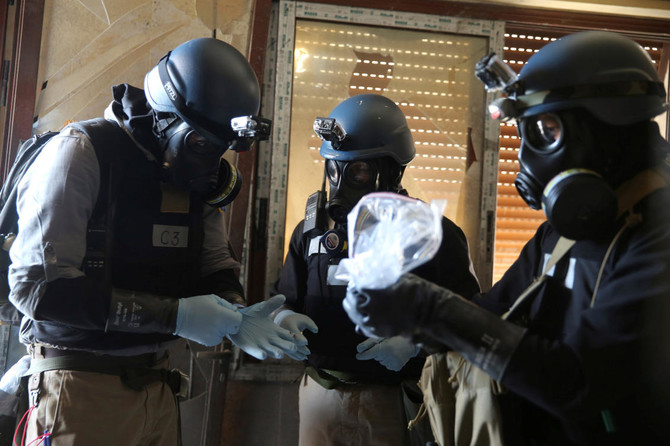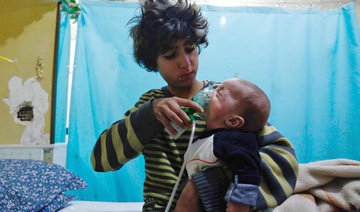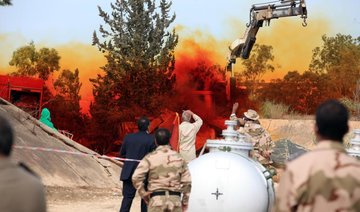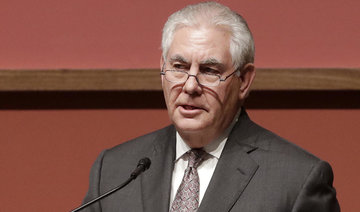WASHINGTON: The Trump administration on Thursday accused Syrian President Bashar Assad’s government of producing and using “new kinds of weapons” to deliver deadly chemicals despite committing to abolish its program in 2013, and said the world must find a way to stop it.
President Donald Trump has not ruled out additional military action to deter attacks or punish Assad, administration officials said, although they did not suggest any action was imminent. They emphasized that the United States was seeking a new way to hold chemical weapons-users accountable and wanted cooperation from Russia, Assad’s patron, in pressuring him to end the attacks.
Raising the alarm about the continued threat, US officials said it was “highly likely” that Assad kept a hidden stockpile of chemical weapons after 2013 that he failed to properly disclose. They said information gathered from recent alleged attacks also suggested that Assad retained a “continued production capacity” — also banned under the 2013 deal.
There were no indications that the Syria government, after seven years of civil war, had developed new, deadlier chemicals. Rather, the officials said they believed the weapons used to distribute the chemicals had evolved to become more sophisticated, potentially to evade international capability by making the origins of attacks harder to trace. The officials weren’t authorized to speak on the record and briefed reporters on condition of anonymity.
More recent attacks have involved both chlorine, which has nonchemical uses and is easier to acquire, and the more sophisticated chemical sarin, the officials said. They said that in recent years, Assad has also adjusted his tactics to reduce the chances that attacks will be attributed to his forces.
That has made evidence-collection more difficult, though the US believes it has a firm understanding of the extent of chemical use in Syria through a combination of intelligence, sample testing by third countries, and social media and other open-source information, the officials said.
Assad’s government has denied using chemical weapons, and its chief ally, Russia, has claimed that the reports are false attempts to pressure Syria’s government or provocations perpetrated by opposition groups. Syria and Russia have dismissed the conclusions of the Joint Investigative Mission, an expert body set up by the set up by the United Nations and Organization for the Prohibition of Chemical Weapons, that determined Assad’s government used chlorine gas in 2014 and 2015, and sarin in April 2017.
Use of such widely deplored weapons comes with great risk for Assad, raising questions about why he would take the chance. But the officials said the US believes Assad’s government sees chemical attacks as an effective way to terrorize rebels and sympathetic populations into fleeing, therefore altering the demographic balance in the Alawite heartland where Assad is trying to consolidate control.
Yet Syria’s government isn’t the only chemical weapons threat in the region, according to the officials. Daesh continue to use them, they said, although the militants’ arms are said to be more rudimentary.
Though Daesh no longer controls large parts of Syria or Iraq, the officials said the extremist group continues to use sulfur mustard, via artillery shells, and chlorine, delivered by improvised explosive devices. The officials noted that the underlying chemicals are easy to acquire or produce, and said the US does not believe Daesh has gotten ahold of military stockpiles in either Iraq or Syria.
Years of efforts by two US presidents have failed to end the harrowing reports on chemical weapons use in Syria.
Under President Barack Obama, the United States stopped short of striking Assad’s forces in response, but brokered a deal with Russia to rid Syria of its stockpiles. After another alleged attack in April 2017, President Donald Trump ordered a retaliatory missile strike, but 10 months later, the US and international observers say the weapons are still used.
Reports of chemical attacks have continued to stream in from Syria, including as recently as Thursday, when rescue workers in the rebel-held Damascus suburb of Douma reported what they described as a suspected chlorine gas attack that injured a number of civilians. The opposition-run Ghouta Media Center reported in a posting on its Facebook page that three people were killed and dozens suffered shortness of breath as a result of surface to surface missiles, some of them carrying chlorine gas.
The reports could not be independently verified and the Britain-based Syrian Observatory for Human Rights, which monitors the war in Syria via activists on the ground, was unable to confirm the reports either. The accounts followed a suspected attack in late January near Damascus that activists and rescue teams said affected nearly 20 civilians.
US says Syria may be making new types of chemical weapons
US says Syria may be making new types of chemical weapons

Sudan paramilitaries say will open ‘safe passages’ out of key Darfur city
The RSF, battling the regular army for more than a year, affirmed in a post on X late Friday “the readiness of its forces to help citizens by opening safe passages to voluntarily leave to other areas of their choosing and to provide protection for them.”
El-Fasher, the state capital of North Darfur and once a key hub for humanitarian aid where many had gathered for shelter, has been in the grips of fighting as the RSF seeks to control it.
The paramilitaries called on residents of El-Fasher to “avoid conflict areas and areas likely to be targeted by air forces and not to respond to malicious calls to mobilize residents and drag them into the fires of war.”
Sudan has been in the throes of conflict for over a year between the regular army led by de facto ruler Abdel Fattah Al-Burhan and the RSF led by his former deputy Mohamed Hamdan Dagalo.
The conflict has killed as many as 15,000 people in the West Darfur state capital of El-Geneina alone, according to United Nations experts.
Medical charity Doctors Without Borders on Wednesday said its hospital in North Darfur had received more than 450 people killed in the fighting since May 10, but noted that the actual death toll was likely much higher.
Also on Wednesday, the UN’s humanitarian coordinator said residents of Sudan were “trapped in an inferno of brutal violence” and increasingly at risk of famine due to the rainy season and blocked aid.
Tens of thousands of people have died and millions have been displaced since the war broke out in April 2023.
The UN on Friday warned it only had 12 percent of the $2.7 billion it sought in funding for Sudan, warning that “famine is closing in.”
Funerals offer displaced Lebanese villagers a chance to go home

- Many residents of towns and villages on either side of the Israel-Lebanon border have evacuated their homes for safety
MAIS AL JABAL: For displaced south Lebanese villagers, funerals for those killed in months of cross-border clashes are a rare chance to return home and see the devastation caused by Israeli bombardment.
“My house is in ruins,” said Abdel Aziz Ammar, a 60-year-old man with a white beard, in front of a pile of rubble in the border village of Mais Al-Jabal.
Only a plastic water tank survived.
“My parents’ house, my brother’s house and my nephew’s house have all been totally destroyed,” said Ammar, who was back in Mais Al-Jabal this week for the funeral of a Hezbollah fighter from the village.
Many residents of towns and villages on either side of the Israel-Lebanon border have evacuated their homes for safety.
The Iran-backed Lebanese movement has been intensifying its attacks, while Israel has been striking deeper into Lebanese territory, in cross-border violence that has killed at least 419 people on the Lebanese side, according to an AFP tally.
Most of the dead are Hezbollah fighters, including seven from Mais Al-Jabal, but at least 82 are civilians, three of whom journalists.
Israel says 14 soldiers and 11 civilians have been killed on its side of the border.
For funerals in the south, the Lebanese army informs United Nations peacekeepers, who then inform the Israeli military, a spokesperson for the United Nations Interim Force in Lebanon said.
The peacekeepers usually patrol near the border, and act as a buffer between Lebanon and Israel.
Ammar fled his village for Beirut’s southern suburbs, a Hezbollah stronghold, two weeks after the violence broke out.
The International Organization for Migration says more than 93,000 people have been displaced in south Lebanon, while authorities in Israel have evacuated tens of thousands from the country’s north.
“We come for the funerals, but we inspect our homes. Those whose houses haven’t been destroyed use the time to collect their belongings,” Ammar said.
“The house meant a lot to us, it was big,” with plenty of space for the children outside, he said of his home in Mais Al-Jabal.
“My daughter always tells me, ‘I miss the house, when will we go back?’”
An AFP photographer saw dozens of houses razed or partially destroyed in the village, which resembled a battlefield surrounded by green countryside.
A funeral procession crossed the rubble-strewn streets, with people chanting slogans in support of Hezbollah, not far from Israeli positions across the border.
Hezbollah flags fluttered in the wind as women in chadors walked together, some wearing yellow scarves -the color of the Shiite Muslim movement — or holding pictures of the fallen “martyr”.
“Whether I carry a weapon or not, just my presence in my village means I am a target for the Israelis,” Ammar said, noting the fighting does not always stop for the funerals.
On May 5, a man, his wife and two children were killed in a strike on Mais Al-Jabal while a funeral took place.
They had returned to the village to collect things from a store they owned, believing it to be a moment of calm, local media reported.
In front of a half-destroyed house, people piled a small truck with whatever they could — a washing machine, a child’s stroller, a motorbike and plastic chairs.
Amid rubble in the village, a sign was propped up reading: “Even if you destroy our houses, your missiles cannot break our will.”
Lebanese authorities are waiting for a ceasefire to fully assess the damage, but have estimated that some 1,700 houses have been destroyed and 14,000 damaged.
Emergency personnel have reported huge damage and villages emptied of residents, while many journalists have been reluctant to travel to the border areas due to the heavy bombardment.
The overall bill already exceeds $1.5 billion, authorities estimate, in a crisis-hit country where compensation procedures remain vague.
But to village resident Khalil Hamdan, 53, who also attended the funeral, “the destruction doesn’t make a difference.”
“We will rebuild,” he told AFP.
Oil tanker hit by missile off Yemen: security firm

- The vessel and crew are safe and continuing to its next port of call: UKMTO
- The incident occurred 76 nautical miles (140 kilometers) off Yemen’s Hodeidah
DUBAI: A crude oil tanker was hit by a missile off the coast of Yemen’s rebel-held city of Mokha overlooking the strategic Bab Al-Mandeb strait, maritime security firm Ambrey said Saturday.
“A Panama-flagged crude oil tanker was reportedly ‘attacked’” about 10 nautical miles southwest of Mokha, Ambrey said, adding that information “indicated the vessel was hit by a missile and that there was a fire in the steering gear flat.”
The British navy’s maritime security agency had earlier said it received a report of a vessel “sustaining slight damage after being struck by an unknown object.”
“The vessel and crew are safe and continuing to its next port of call,” United Kingdom Maritime Trade Operations (UKMTO) added.
It said the incident occurred 76 nautical miles (140 kilometers) off Yemen’s Hodeidah, without specifying the type of vessel involved.
The Iran-backed Houthis, who control much of Yemen, have launched dozens of attacks on vessels in and around the Red Sea since November in a campaign they say is in solidarity with Palestinians in war-torn Gaza.
The milita attacks have prompted reprisal strikes by US and British forces and the formation of an international coalition to protect the vital shipping lanes through the Gulf of Aden and the Red Sea.
Israeli forces kill senior Palestinian militant in Jenin: army

- The strike by a fighter jet and helicopter killed Islam Khamayseh
- Khamayseh was a leader of the Jenin Battalion
RAMALLAH: The Israeli military said on Saturday it killed a senior Palestinian militant during an air strike on an “operations center” in the occupied West Bank city of Jenin.
“A number of significant terrorists were inside the compound,” the Israeli Defense Forces said in a statement posted to Telegram.
It said the strike by a fighter jet and helicopter killed Islam Khamayseh, a “senior terrorist operative in the Jenin Camp” who was responsible for a series of attacks in the area.
The Al-Quds Brigade, the armed wing of militant group Palestinian Islamic Jihad, confirmed in a statement that Khamayseh was killed and several others wounded during an Israeli raid on Friday night.
It said Khamayseh was a leader of the Jenin Battalion, which is affiliated with Islamic Jihad.
The Palestinian Ministry of Health said one person was killed and eight were wounded and receiving hospital treatment as a result of Israel’s operation in Jenin on Friday night.
Israel has occupied the West Bank since 1967 and its troops routinely carry out incursions into areas such as Jenin, which are nominally under the Palestinian Authority’s security control.
The West Bank has seen a recent surge in violence, particularly since the Israel-Hamas war erupted on October 7.
More than 500 Palestinians have been killed by Israeli forces or settlers across the West Bank since October 7, according to Palestinian officials, and at least 20 Israelis have been killed over the same period, according to an AFP tally based on official Israeli figures.
The Gaza Strip has been at war since Hamas’s unprecedented attack on October 7 resulted in the deaths of more than 1,170 people in Israel, most of them civilians, according to an AFP tally based on official Israeli figures.
Israel’s retaliatory offensive on the Hamas-ruled Gaza Strip has killed at least 35,303 people, most of them civilians, according to the Hamas-run territory’s health ministry.
Fierce fighting in northern Gaza as aid starts to roll off US-built pier

- Residents say Israeli bulldozers demolishing homes, shops in Jabalia
- Hamas says US floating aid pier no substitute for end to Israeli siege
CAIRO: Israeli forces battled Hamas fighters in the narrow alleyways of Jabalia in northern Gaza on Friday in some of the fiercest engagements since they returned to the area a week ago, while in the south militants attacked tanks massing around Rafah.
Residents said Israeli armor had thrust as far as the market at the heart of Jabalia, the largest of Gaza’s eight historic refugee camps, and that bulldozers were demolishing homes and shops in the path of the advance.
“Tanks and planes are wiping out residential districts and markets, shops, restaurants, everything. It is all happening before the one-eyed world,” Ayman Rajab, a resident of western Jabalia, said via a chat app.
Israel had said its forces cleared Jabalia months earlier in the Gaza war, triggered by the deadly Hamas-led attacks on southern Israel on Oct. 7, but said last week it was returning to prevent Islamist militants re-grouping there.
In southern Gaza bordering Egypt, thick smoke rose over Rafah, where an escalating Israeli assault has sent hundreds of thousands of people fleeing from what was one of the few remaining places of refuge.
“People are terrified and they’re trying to get away,” Jens Laerke, UN humanitarian office spokesperson, said in Geneva, adding that most were following orders to move north toward the coast but that there were no safe routes or destinations.
As the fighting raged, the US military said trucks started moving aid ashore from a temporary pier, the first to reach the besieged enclave by sea in weeks.
The World Food Programme, which expects food, water, shelter and medical supplies to arrive through the floating dock, said the aid was transported to its warehouses in Deir Al Balah in central Gaza and told partners it was ready for distribution.
The United Nations earlier reiterated that truck convoys by land — disrupted this month by the assault on Rafah — were still the most efficient way of getting aid in.
“To stave off the horrors of famine, we must use the fastest and most obvious route to reach the people of Gaza – and for that, we need access by land now,” deputy UN spokesperson Farhan Haq said.
US aid was arriving in Cyprus for delivery to Gaza via the new pier, Washington said.
Hamas demanded an end to Israel’s siege and accused Washington of complicity with an Israeli policy of “starvation and blockade.”
The White House said US national security adviser Jake Sullivan would visit Israel on Sunday and stress the need for a targeted offensive against Hamas militants rather than a full-scale assault on Rafah.
A group of US medical workers left the Gaza Strip after getting stuck at the hospital where they were providing care, the White House said.
Humanitarian fears
The Israel Defense Forces said troops killed more than 60 militants in Jabalia in recent days and located a weapons warehouse in a “divisional-level offensive.”
A divisional operation would typically involve several brigades of thousands of troops each, making it one of the biggest of the war.
“The 7th Brigade’s fire control center directed dozens of airstrikes, eliminated terrorists and destroyed terrorist infrastructure,” the IDF said.
At least 35,303 Palestinians have now been killed, according to figures from the enclave’s health ministry, while aid agencies have warned repeatedly of widespread hunger and dire shortages of fuel and medical supplies.
Israel says it must capture Rafah to destroy Hamas and ensure the country’s safety. In the Hamas attack on Oct. 7, 1,200 people died in Israel and 253 were taken hostage, according to Israeli tallies. About 128 hostages are still being held in Gaza.
Israel said on Friday that its forces retrieved the bodies of three people killed at the Nova music festival in Israel on Oct. 7 and taken into Gaza.
In response, Hamas said negotiations were the only way for Israel to retrieve hostages alive: “The enemy will not get its prisoners except as lifeless corpses or through an honorable exchange deal for our people and our resistance.”
Talks on a ceasefire have been at an impasse.
‘Tragic war’
Israeli tanks and warplanes bombarded parts of Rafah on Friday, while the armed wings of Hamas and Islamic Jihad said they fired anti-tank missiles and mortars at forces massing to the east, southeast and inside the Rafah border crossing with Egypt.
UNRWA, the main UN aid agency for Palestinians, said more than 630,000 people had fled Rafah since the offensive began on May 6.
“They’re moving to areas where there is no water — we’ve got to truck it in — and people aren’t getting enough food,” Sam Rose, director of planning at UNRWA, told Reuters on Friday by telephone from Rafah, where he said it was eerily quiet.
At the International Court of Justice, or World Court, in The Hague, where South Africa has accused Israel of violating the Genocide Convention, Israeli Justice Ministry official Gilad Noam defended the operation.
The South African legal team, which set out its case for fresh emergency measures the previous day, framed the Israeli military operation as part of a genocidal plan aimed at bringing about the destruction of the Palestinian people.


















